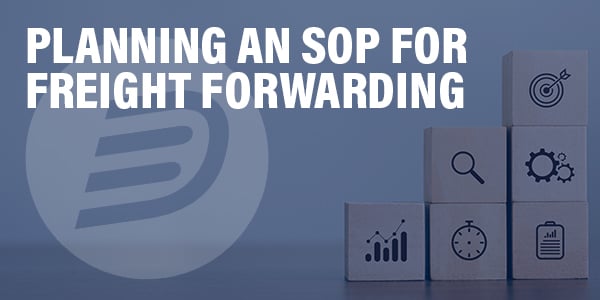
This blog post was originally published on 2/21/2022 and was updated on 1/17/2024.
Trying to ship without a freight forwarding standard operating procedure (SOP) is like trying to drive a car without starting the engine. The SOP is necessary to ensure operations between importers, freight forwarders, carriers, and other stakeholders run smoothly.
With an SOP, trade partners work in tandem to move goods from Point A to Point B. Without an SOP, bad procedures—or worse, no procedures at all—guide the shipping process, leading to chaos, preventable errors, wasted time, and costly fees and fines.
SOPs put all trade partners on the same page as they move your goods. When delays or complications arise, everyone refers to the SOP for guidance to ensure a consistent response.
The good news is that most logistics coordinators already operate by an SOP in their daily operations. The bad news is that they often fail to record these procedures. While that approach works for internal logistics operations, it leaves those outside the company to make logistics decisions in a vacuum.
When moving freight, it’s critical to create a written SOP and share it with all trade partners, update it regularly, and refer to it when questions arise.
What is an SOP?
An SOP collates everything that supply chain and logistics partners have agreed upon into a single living document. When delays or other complications arise along a shipping route, all stakeholders can refer to the SOP to determine the best way to respond.
A freight forwarding SOP sets expectations for everyone involved in moving a shipment—from the importer to the freight forwarder, carrier, and others. It communicates your expectations to logistics partners and details step-by-step processes for handling specific situations. These documents also cover the various services your freight forwarder will provide.
An SOP is not a contract or a quote. These documents may list rates, but they also contain information about Customs documentation requirements, Import Security Filings, packaging needs, Country of Origin, CTPAT requirements, stakeholder responsibilities, and more.
Shippers should establish SOPs for every customer and every stakeholder, as all are not the same. The SOP paints an individualized picture of each business, addressing diverse cultures and customs to ensure nothing gets lost in translation.
While an SOP may also include information found on invoices or quotes, you still need to document that information in this format. The documents in an SOP put everyone on the same page and ensure they follow the correct steps when moving your goods to comply with Customs documentation requirements and to pay the correct fees and taxes.
What Goes into an SOP?
Do not create your freight forwarding SOP in a vacuum. Involve all trade partners in its creation to craft a document everyone understands and will follow.
Spell out everything in the SOP in exacting detail. Ideally, if your main contact gets sick and cannot work, the person filling in can reference the SOP and know what to do.
A comprehensive freight forwarding SOP includes:
- Origin contract
- Email addresses for pre-alerts and shipment status
- ISF and Customs data
- Chain of contact
- Invoicing information
- Information about your product or commodity, including commodity code
- Cargo details
- Special details: Note if shipments are oversize or contain hazardous material
- Routing details
- Delivery schedules
- Brokerage information
- Escalation approval and procedures
- Business requirements
- Billing requirements (15-day or 30-day)
- Communication expectations, such as reporting requirements and relationship reviews
All of the above information must be correct. Incorrect information can cause delays, and every delay can cost money, damage customer relationships, and even bankrupt your business.
Who Needs an SOP?
Who needs an SOP? Everyone, especially now that many people work remotely. These documents ensure trade partners follow the same procedures no matter where they are—even if they work from a home office.
Put an SOP in place before engaging with a new trade partner or share your existing SOP with them before moving forward. These documents protect everyone.
Let’s say Roberta in billing is sick. The SOP shares who to contact when she’s out. You can reach out to that person, and they can perform her duties by following the billing steps listed in the SOP. Or, maybe your shipment is 50 pounds overweight. What happens then? The SOP clarifies when notifications must be made with an overweight shipment and who to notify. Again, any contact can refer to the SOP to manage overweight shipments.
Related Content: 5 Ways to Plan for Shipping Delays
Including information about your commodity gives everyone a better understanding of the shipment and any extra steps involved. Are Partner Government Agencies, such as the FDA, EPA, or FCC, required? Details about your shipments help a freight forwarder put the proper plan in place for your goods. If you are shipping hazardous goods and someone new starts managing your shipments, they know by glancing at the SOP that there are special steps to follow due to the sensitive nature of your goods.
An SOP also might include cargo details. For instance, it could specify that you want 50% of your goods going to the West Coast and the other 50% shipped to the East Coast. Including this information in your SOP ensures that whoever touches your account will ship your cargo where you want it to go.
Creating a written SOP with your trade partners will help build contingency plans for shipping your goods. The SOPs you generate for each product, customer, and shipping lane will improve communication between stakeholders and help you avoid costly delays and fines.




